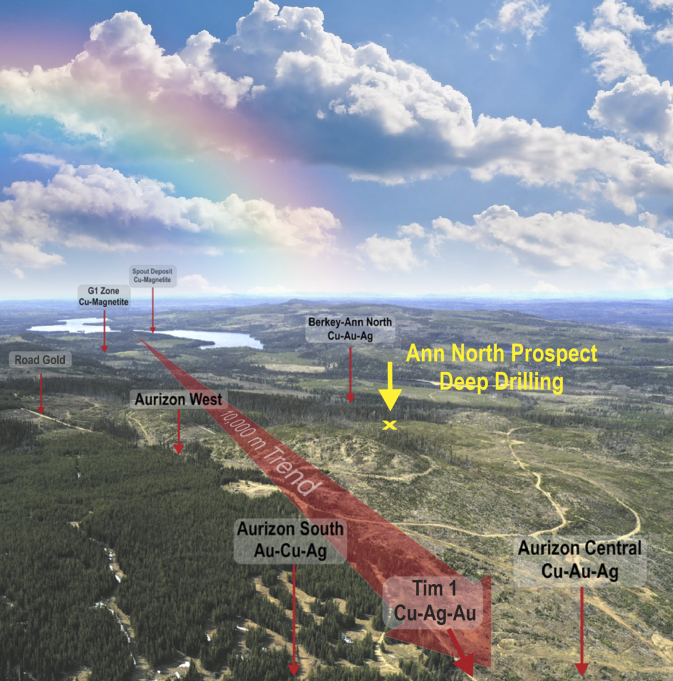The Ann North Alkalic Porphyry Copper-Gold prospect, located 3km east of the G1 Copper Deposit and 2.4_km north west of the Aurizon South Gold Deposit, was explored extensively by the Company from 2000 to 2004. Drilling focused primarily on mineralization to shallow depths of 200 to 300 metres below surface, such as DDH AN 04-19 which intersected 234 m grading 0.24% Cu & 0.34 gpt Au, including 1% Cu & 4.4 gpt Au over 4m, 0.58% Cu & 0.4gpt Au over 12m.
Our current exploration is strategically focused, searching below shallow, mineralized zones like Ann North for potential “roots”, similar to several alkalic copper porphyry deposits elsewhere within the Quesnel Trough (Mount Polley, New Afton, Red Chris, MPD and others) where large intervals of higher grade and possibly underground-mineable material are now emerging.
At Ann North, highly encouraging results from seventeen historical holes drilled to an average depth of 230m from surface (4500 m total drilling) have been interpreted in concert with data from soil geochemical, induced polarization, gravity and magnetic data. The copper-gold mineralization occurs as a series of elongated and faulted lenses within monzonite and quartz monzonite, disrupted by a series of interpreted north-northwest faults. The currently defined zone is surrounded by high induced polarization chargeability, which lies within a distinct, circular magnetic low anomaly. Drilling conducted in 2000 and 2004 supports the geophysical patterns, as the better copper grades in the core of the zone are associated with magnetite destructive potassic alteration, enveloped by peripheral pyrite-rich, propylitic alteration.
Copper mineralization occurs mainly as chalcopyrite with minor bornite and chalcocite in several subparallel panels striking to the north-northeast and extending over a distance of at least 350 m. The widest zone is interpreted as about 30 m thick but since drill holes were oriented at an angle to the strike of the copper mineralization, true thickness of individual zones is not known. Copper grade is suggested from drilling results to date to be in the order of 0.2 to 0.3% but with narrow, higher-grade intersections.
The strike and depth limits of known copper mineralization at Ann North have not yet been defined. Three-dimensional modelling suggests the low-chargeability core dips northwesterly.
In 2020, a single, steeply angled hole was drilled to 803 m on the west side of the zone to test for westerly depth extension. The upper 500m of this hole encountered intense potassic alteration and low-grade, disseminated chalcopyrite, trace bornite and possible molybdenite, but weaker alteration within the lower 300m suggests the zone dips more northerly than had been interpreted from historical drill sections.
In 2021, additional deeper drilling at Ann North will target the interpreted depth extent of the mineralization.

